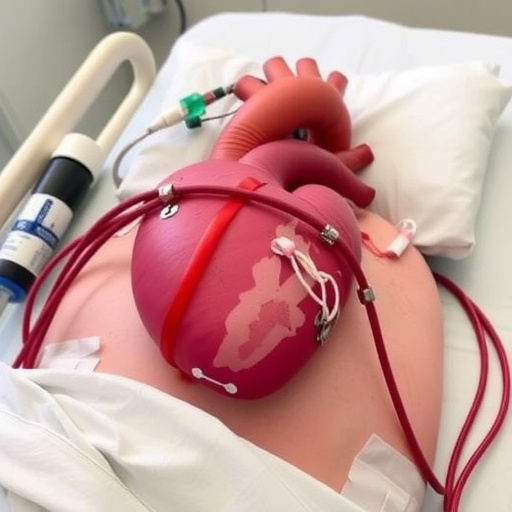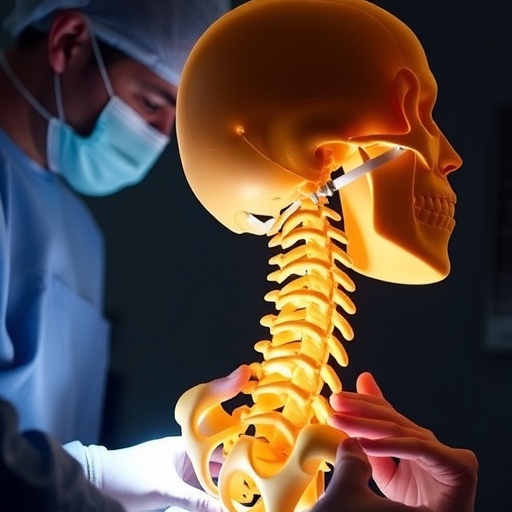
In a groundbreaking medical advancement, researchers have achieved a remarkable feat in the field of cardiac support technology. A recent study published in the Journal of Artificial Organs highlights the successful resuscitation of a patient experiencing restart failure of a left ventricular assist device (LVAD), a device that plays a crucial role in supporting patients with severe heart failure. This case not only demonstrates the resilience of modern medical technologies but also paves the way for future innovations in treating cardiac complications, particularly in patients with complex conditions such as aortic valve closure.
The patient in question was grappling with severe heart failure and had undergone implantation of the LVAD. This mechanical pump is designed to assist the heart in circulating blood throughout the body, thereby alleviating the symptoms associated with heart failure. In this specific case, however, the patient faced a perilous situation where the device failed to restart, posing a significant threat to the patient’s life. This rare but critical complication highlights the potential vulnerabilities of LVAD technology, emphasizing the need for continuous monitoring and advanced troubleshooting protocols to ensure patient safety.
The medical team intervened rapidly, employing a series of sophisticated resuscitation strategies to stabilize the patient. Their comprehensive approach included the administration of pharmacological agents, which aimed to enhance myocardial contractility and optimize hemodynamic parameters. In addition to pharmacotherapy, the team utilized advanced monitoring technologies to assess the patient’s vital signs and ensure the efficacy of their interventions. This meticulous attention to detail was paramount in preventing a potential fatality.
Understanding the complexities of LVAD technology is essential for unraveling the challenges faced by clinicians in such critical scenarios. These devices, while life-saving, require a delicate balance between mechanical support and biological response. The integration of artificial devices into the human body often presents unique challenges, particularly in patients with underlying pathologies such as aortic valve closure, which can significantly affect hemodynamics and overall cardiac function.
One of the notable aspects of this case was the role of interdisciplinary collaboration. The medical team consisted of cardiologists, cardiac surgeons, and critical care specialists who worked cohesively to address the multifaceted issues presented by the patient. Their collaboration was integral to the successful management of the restart failure, showcasing the value of teamwork in high-stakes medical situations. This case serves as a reminder that complex patient care often requires a multidisciplinary approach to achieve optimal outcomes.
As the patient was stabilized, further assessments were conducted to evaluate the functionality of the LVAD. Advanced imaging techniques, including echocardiography, were employed to visualize the heart’s structure and function in real-time. These imaging modalities proved invaluable in identifying the issues surrounding the device’s failure, allowing for targeted interventions to restore normal operation. This detailed diagnostic approach emphasizes how modern technology enhances our ability to understand and resolve complications associated with mechanical circulatory support.
The authors of the study underlined the implications of their findings for future cardiac support strategies. They emphasized the importance of ongoing research to improve LVAD technology and enhance patient outcomes. Lessons learned from this case may inform the design of next-generation devices that are equipped with advanced fail-safety mechanisms and real-time monitoring capabilities, further mitigating the risks associated with restart failures.
Ethical considerations also arise in the context of such a high-risk intervention. The medical team faced critical decisions regarding the extent of resuscitative efforts in light of the patient’s overall prognosis. Balancing the potential benefits of continued invasive interventions against the risks associated with prolonged device malfunction required thoughtful deliberation. This ethical dimension underscores the complexity of managing patients with advanced heart failure and the profound impact of clinical decision-making on patient outcomes.
The successful resuscitation reported in this case is particularly significant as it challenges the prevailing narratives of LVAD dependence. Many patients with artificial heart devices may develop psychological and emotional challenges related to their reliance on mechanical support. This case illustrates that maintaining resilience amid such reliance is imperative, as the possibility of recovery and continued life is within reach, even in challenging circumstances.
As the medical community examines this case, it serves as a clarion call for enhanced training programs focused on the management of LVADs. Hospitals and healthcare systems are urged to develop comprehensive protocols that include simulation training and educational resources for clinicians. Such initiatives can ensure that healthcare professionals are well-equipped to handle emergencies associated with mechanical circulatory support devices, ultimately leading to improved patient safety and outcomes.
Moreover, the implications of this research extend beyond individual cases, shedding light on the need for systemic changes in how cardiac care is delivered. Policymakers and healthcare leaders must recognize the importance of investing in research and development for advanced cardiac technologies. By advocating for funding and support for innovation in cardiac support devices, the medical community can foster an environment where life-threatening complications become increasingly rare.
In summary, the successful resuscitation from restart failure of an LVAD in a patient with aortic valve closure marks a significant milestone in cardiac care. It highlights the complexities of managing patients who rely on advanced mechanical support while also exemplifying the potential for innovation in medical technology. As researchers continue to explore ways to enhance the functionality and reliability of LVADs, the hope remains that such breakthroughs will lead to improved quality of life for patients experiencing severe heart failure.
The narrative woven through this case reflects the resilience of both patients and healthcare professionals in the face of adversity. The lessons learned here not only contribute to the growing body of knowledge in cardiac support technology but also inspire future generations of medical practitioners to continue pushing the boundaries of what is possible in the realm of patient care. This case is a testament to the power of collaboration, innovation, and unwavering commitment to patient survival.
In the world of medicine, each case contributes to a larger narrative of human health and recovery. It reinforces the notion that with persistence, teamwork, and a focus on advancing technology, the seemingly impossible can indeed become achievable. The journey of this patient exemplifies the remarkable intersections of medical science and compassionate care, leading the way for further advancements in the field of artificial organs and cardiac support systems.
With ongoing advancements in technology and the collective knowledge of healthcare providers, the future for patients with severe cardiac complications seems brighter than ever. The successful resuscitation in this scenario not only showcases the capabilities of modern medical interventions but also serves as a beacon of hope for patients and families navigating the complexities of heart failure.
As we continue to explore the frontiers of medical innovation, this case will undoubtedly inspire further research and development, prompting a continuous strive towards making heart disease more manageable and transforming the patient experience in profound ways.
Subject of Research: Successful resuscitation techniques for LVAD restart failures.
Article Title: Successful resuscitation from restart failure of left ventricular assist device in a patient with aortic valve closure.
Article References:
Ichihara, Y., Hattori, M., Echie, Y. et al. Successful resuscitation from restart failure of left ventricular assist device in a patient with aortic valve closure.
J Artif Organs (2025). https://doi.org/10.1007/s10047-025-01513-y
Image Credits: AI Generated
DOI: 10.1007/s10047-025-01513-y
Keywords: LVAD, restart failure, cardiac support, resuscitation, heart failure, aortic valve closure, multidisciplinary care, ethical considerations, patient safety.
Tags: advanced heart failure treatmentaortic valve closure complicationscardiac health innovationschallenges in LVAD operationemergency response in heart failure casesinnovative cardiac support devicesJournal of Artificial Organs study findingsLVAD failure managementmechanical circulatory support technologypatient safety in cardiac careresuscitation protocols for LVAD patientssuccessful cardiac resuscitation techniques




